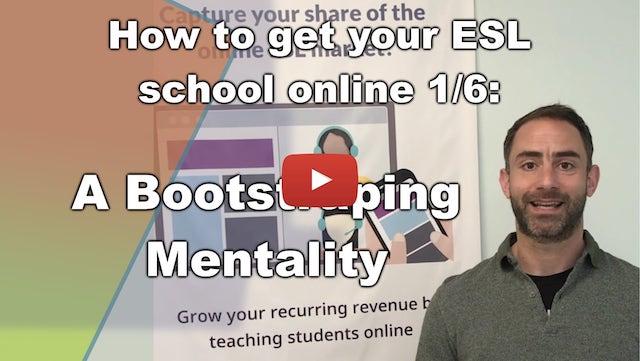7 min read
Share this post

In this post, we’ll talk how to start an online ESL School on a budget! We’ll include the key pieces of infrastructure that you’ll have to make decisions around to get your school up and running. The good news is that they’re not hard to find and they’re all commoditized so you’ll have lots of good options!
Recently Kris Jagasia (Off2Class CEO & Co-founder) presented at the EFL Magazine’s TOEFL Training Summit for Teachers and School Owners/ Managers. Check out his presentation below:
.
.
.
If you already have a brick and mortar ESL school, check out our webinar for how to transition online!
.
.
.
To start off, we’ll talk about a critical element you need to understand when transitioning online: a bootstrapping mentality. Basically, the idea is to use tools that are free and inexpensive to get out of the gates!
The concept of bootstrapping is important to start an online ESL school: instead of going out and buying an expensive piece of software to do everything for you, you can use tools that are free or low cost and combine them to create a system that gets you online. We’re looking for free tools that solve 95% of the problem. This will help you to be as capital-efficient as possible.
You might think the process to start an online ESL school will be difficult: integrating bookings, payments, teaching platforms, etc. And how will you manage these systems with large numbers of students? But having so many students that you’re struggling to stay organized is a great problem to have. Once you have that problem, you’ve already succeeded, and at that point you can convert from the bootstrapped solution to the fancy solution. but for now the focus is getting out of the gates!
.
.
.
To start an online ESL school, it’s important to know the distinction between synchronous and asynchronous ESL lessons. Synchronous means teachers and students meeting at the same time, usually by video conference. Asynchronous means the student is doing self study activities. Your school will fall somewhere along the continuum between synchronous and asynchronous.
Wherever you are, we always advocate using a teacher-directed approach. This is the same approach you would use for a physical school — it applies to online schools too! Students can’t be left to their own devices without teachers being at the center of the learning equation. This is true even for the asynchronous part, with your teachers making comments and giving feedback on student work.
At the end of the day, if you’re not using your teachers when you go online, you’re just another Duolingo. You don’t want to compete with software, since your students know that Duolingo is free and pretty good
.
.
.
Now we’re ready to discuss the first key piece of infrastructure you’ll need to start an online ESL school: video conferencing systems. It’s not a hard decision, as there are many excellent free and low-cost options. We generally recommend Zoom!
To start with, your students and teachers need a way to see and hear each other. This is hugely commoditized so there are a ton of options to choose from, and low cost/free. So this should be an easy decision..
We recommend Zoom because it’s easy and lightweight. However, you can use any system you want as long as it’s reliable and works well in bandwidth situations.
Find one that works for you, check it off, and move on.
With Zoom, you can absolutely use a free accounts, with the only limit being that group lessons are limited to 40 minutes, That’s an ideal break time and you can re-start that same zoom meeting five minutes later.
.
.
.
Now let’s discuss the second key piece of infrastructure you’ll need to make a decision on: payments.
You need a way to take web payments since they wont’ be in a physical school. If you’ve never done this before, use PayPal. It’s recognizable all over the world, and it’s used even in places where credit cards aren’t common.
Where most people get stuck is integrating payments to accounts. If a student buys a 10 class pack, for example, how do you keep track?
You could buy expensive software, but we want to bootstrap and keep it simple. Instead, combine payments with a freelancer or VA who you can hire online for a few hours a week at an affordable rate. You can find someone on Upwork or another site like it, interview some freelancers, and find someone competent and thorough. It will be easier and much more cost-effective!
.
.
.
Now we’ll discuss the third key piece of infrastructure you’ll need to make a decision on: scheduling. As with video conferencing and payments, there are a multitude of free and low-cost options, and we recommend Google Calendar and Calendly.
Teachers and students will have to know when they’re meeting, so you need a scheduling solution. In keeping with the theme, these solutions are very commoditized, and effectively free.
Google calendar is the de facto tool people use, but there are a number of other systems you can use. The choice will depend on your business model. If you’re selling access to pre-scheduled classes, then it’s just like in a physical school. The student registers, and your or a freelancer can send recurring calendar invitations, so they know when to attend.
If you want to create an on-demand structure where the student buys 10 classes they can book at any time, then a tool like Calendly is a great option. Teachers set availability and it creates a URL that showing teacher availability, and the student can use that URL to book the classes.
You can also use a freelancer (especially if you had one for payments), to keep track of scheduling as well.
.
.
.
Now let’s discuss the fourth key piece of infrastructure you’ll need to make a decision on: Education infrastructure. This is what you’ll actually use for your synchronous and asynchronous teaching materials, and this is the most important piece, for two reasons:
“Content” here means what you’re going to be using for your live synchronous lessons, as well as asynchronous homework that students can complete between classes, as well as placement testing that you’ll use to put new students on your platform
when it comes to synchronous online lessons, it’s a bit different from what you use in a physical classroom. You want content that is:
For the asynchronous part, it works best if it’s connected to synchronous lessons. To help maintain the teacher-led feel, it helps if the asynchronous homework is directly connected to the lesson.
Off2Class is perfectly suited for this role, which is very convenient for anyone who wants to start an online ESL school. It starts with four simple ingredients: Three that are low-cost and easy to find, plus Off2Class!
To learn more on how to get online as quickly and easily as possible, check out this webinar where we talk about the transition:
Share this post



7 Comments
Four easy steps to create your own online teaching system. Really cool. I’ve been using hangouts and jetsi.org with my online students. They’re really cool because they let you look at your student(s) during class.
I’d like to congratulate OFF2CLASS on on their work on advanced lessons. I have done it with some students and not only does it give room for conversation, like, interesting questions that can turn into a 15-minute conversation, but also ut brings up grammar topics which are useful for everyone.
CONGRATULATIONS!!!!!
Thanks Pedro, the “official” announcement on the advanced curriculum is coming soon!
Thanks very much Chris, it ‘s great launch!
This is really helpful. It would be great to hear about marketing tools and tips to get more students to sign up for classes.
Hi Norma, for more info, join our Facebook group for teachers: http://www.facebook.com/groups/off2class/
We want to start an online ESL school…how do we get to monitor how each classes between our teachers and student go? How do we know that the class pushed trough without asking the student? How do we make sure that the students pay the center (us) and not make arrangement directly with the teacher, excluding us, and in the process we lose both the teachers and the students? That’s my main concern as no one would go in to any business, shelling out capital without a guarantee of a secured earning and peace of mind that each transaction is honest to goodness. Thank you for sharing ideas which helps a lot in our feasibility study.
Thank you for sharing this Beth! I am glad Off2Class is helpful to you.